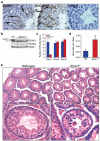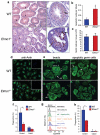Unexpected requirement for ELMO1 in clearance of apoptotic germ cells in vivo
- PMID: 20844538
- PMCID: PMC3773546
- DOI: 10.1038/nature09356
Unexpected requirement for ELMO1 in clearance of apoptotic germ cells in vivo
Abstract
Apoptosis and the subsequent clearance of dying cells occurs throughout development and adult life in many tissues. Failure to promptly clear apoptotic cells has been linked to many diseases. ELMO1 is an evolutionarily conserved cytoplasmic engulfment protein that functions downstream of the phosphatidylserine receptor BAI1, and, along with DOCK1 and the GTPase RAC1, promotes internalization of the dying cells. Here we report the generation of ELMO1-deficient mice, which we found to be unexpectedly viable and grossly normal. However, they had a striking testicular pathology, with disrupted seminiferous epithelium, multinucleated giant cells, uncleared apoptotic germ cells and decreased sperm output. Subsequent in vitro and in vivo analyses revealed a crucial role for ELMO1 in the phagocytic clearance of apoptotic germ cells by Sertoli cells lining the seminiferous epithelium. The engulfment receptor BAI1 and RAC1 (upstream and downstream of ELMO1, respectively) were also important for Sertoli-cell-mediated engulfment. Collectively, these findings uncover a selective requirement for ELMO1 in Sertoli-cell-mediated removal of apoptotic germ cells and make a compelling case for a relationship between engulfment and tissue homeostasis in vivo.
Figures




Similar articles
-
BAI1 is an engulfment receptor for apoptotic cells upstream of the ELMO/Dock180/Rac module.Nature. 2007 Nov 15;450(7168):430-4. doi: 10.1038/nature06329. Nature. 2007. PMID: 17960134
-
RhoG-ELMO1-RAC1 is involved in phagocytosis suppressed by mono-butyl phthalate in TM4 cells.Environ Sci Pollut Res Int. 2018 Dec;25(35):35440-35450. doi: 10.1007/s11356-018-3503-z. Epub 2018 Oct 22. Environ Sci Pollut Res Int. 2018. PMID: 30350139
-
Impaired cell death and mammary gland involution in the absence of Dock1 and Rac1 signaling.Cell Death Dis. 2014 Aug 14;5(8):e1375. doi: 10.1038/cddis.2014.338. Cell Death Dis. 2014. PMID: 25118935 Free PMC article.
-
Role of ELMO1 in inflammation and cancer-clinical implications.Cell Oncol (Dordr). 2022 Aug;45(4):505-525. doi: 10.1007/s13402-022-00680-x. Epub 2022 Jun 6. Cell Oncol (Dordr). 2022. PMID: 35668246 Review.
-
The Sertoli cell in vivo and in vitro.Cell Biol Toxicol. 1992 Jul-Sep;8(3):49-54. doi: 10.1007/BF00130510. Cell Biol Toxicol. 1992. PMID: 1446257 Review.
Cited by
-
Discoidin domain receptor 2 expression increases phagocytotic capacity in sertoli cells of sertoli cell-only syndrome testes.Am J Transl Res. 2022 Sep 15;14(9):6067-6081. eCollection 2022. Am J Transl Res. 2022. PMID: 36247266 Free PMC article.
-
Comparative Morphological, Metabolic and Transcriptome Analyses in elmo1 -/- , elmo2 -/- , and elmo3 -/- Zebrafish Mutants Identified a Functional Non-Redundancy of the Elmo Proteins.Front Cell Dev Biol. 2022 Jul 8;10:918529. doi: 10.3389/fcell.2022.918529. eCollection 2022. Front Cell Dev Biol. 2022. PMID: 35874819 Free PMC article.
-
Fis1 ablation in the male germline disrupts mitochondrial morphology and mitophagy, and arrests spermatid maturation.Development. 2021 Aug 15;148(16):dev199686. doi: 10.1242/dev.199686. Epub 2021 Aug 12. Development. 2021. PMID: 34355730 Free PMC article.
-
Apoptotic cell recognition receptors and scavenger receptors.Immunol Rev. 2016 Jan;269(1):44-59. doi: 10.1111/imr.12376. Immunol Rev. 2016. PMID: 26683144 Free PMC article. Review.
-
Defining Gene Function in Spermatogonial Stem Cells Through Conditional Knockout Approaches.Methods Mol Biol. 2023;2656:261-307. doi: 10.1007/978-1-0716-3139-3_15. Methods Mol Biol. 2023. PMID: 37249877
References
-
- Henson PM. Dampening inflammation. Nat Immunol. 2005;6:1179–1181. - PubMed
-
- Nagata S, Hanayama R, Kawane K. Autoimmunity and the clearance of dead cells. Cell. 140:619–630. - PubMed
-
- Gregory CD, Pound JD. Results of Defective Clearance of Apoptotic Cells: Lessons from Knock-out Mouse Models. In: Krysko DV, Vandenabeele P, editors. Phagocytosis of Dying Cells. Vol. 1. Springer Science; 2009. pp. 271–298.
-
- Zhou Z, Caron E, Hartwieg E, Hall A, Horvitz HR. The C. elegans PH domain protein CED-12 regulates cytoskeletal reorganization via a Rho/Rac GTPase signaling pathway. Dev Cell. 2001;1:477–489. - PubMed
-
- Wu YC, Tsai MC, Cheng LC, Chou CJ, Weng NY. C. elegans CED-12 acts in the conserved crkII/DOCK180/Rac pathway to control cell migration and cell corpse engulfment. Dev Cell. 2001;1:491–502. - PubMed
Publication types
MeSH terms
Substances
Grants and funding
LinkOut - more resources
Full Text Sources
Other Literature Sources
Molecular Biology Databases
Research Materials
Miscellaneous

